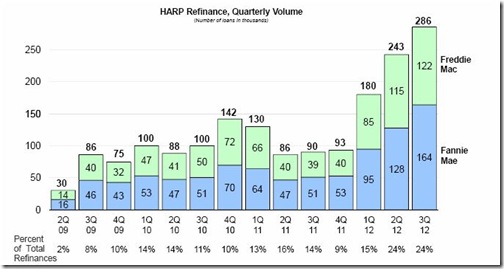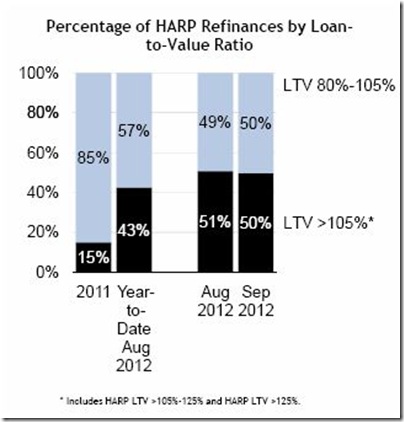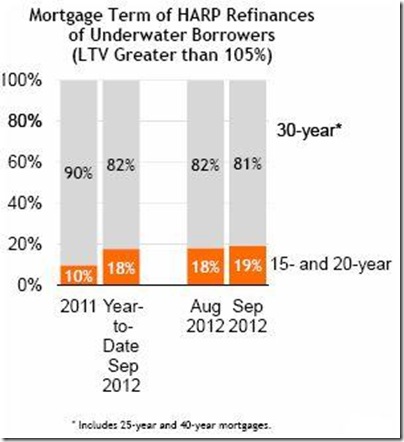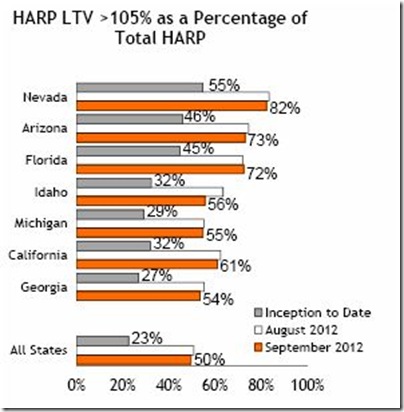The Federal Housing Finance Agency (FHFA) released its September 2012 Refinance Report (Report) on November 28, 2012. The Report provides some statistical information, most of which comes as no surprise to mortgage industry participants, while there are some tidbits of data that seem to demonstrate the impact of the Home Affordable Refinance Program, known as HARP, on the GSEs (viz., Fannie Mae and Freddie Mac). The end date for HARP was extended until December 31, 2013 for loans originally sold to the GSEs on or before May 31, 2009.
HARP was established in 2009 to assist homeowners who are unable to access refinance due to a decline in their home value. The program was originally designed to provide these borrowers with an opportunity to refinance by permitting the transfer of existing mortgage insurance to their newly refinanced loan, or by allowing those without mortgage insurance on their previous loan to refinance without obtaining new coverage.
The premises for HARP are simply stated, as follows:
1) Since the GSEs are already responsible for certain high LTV loans; and
2) Default risk is lowered by allowing a refinance of these high LTV loans; therefore,
3) HARP loans refinancing high LTV loans at lower rates reduce default risk.
One of my concerns with HARP, or as it is referred to now HARP 2.0, is it has failed homeowners because it just is not reaching enough qualified borrowers and many lenders take too long to issue approvals. One remedy would be to have the government expand its guidelines to include non-agency lenders and by removing certain features of the 2009 origination qualifier. Also, low credit scores remain an obstacle by preventing underwater homeowners from taking full advantage of the current HARP guidelines with respect to refinancing eligibility.
HARP has obviously triggered a wave of refinance activity, just as expected. In speaking with several of our clients that are very involved in HARP refinances, it seems that about 50%-75% of their refinance business may be coming from homeowners who have LTVs above 125%. Because the 125% ceiling on LTV was removed, some lenders are actually refinancing LTVs of 155%.
In the following discussion, I will offer some consideration to HARP's most recent survey.*
_____________________________________________________________
IN THIS ARTICLE
Overview
HARP Refinance, Quarterly Volume
Monthly HARP Volume by LTV
Percentage of HARP Refinances by LTV
Mortgage Terms, LTVs Greater than 105%
Total HARP, Percentage of Total Refinances
Timeline for Interest Rate Changes
Library
_____________________________________________________________
Overview
-More than 90,000 homeowners refinanced their mortgage in September through HARP with more than 709,000 loans refinanced since the beginning of this year.
-Since the program’s inception in 2009, the GSEs have financed more than 1.7 million loans through HARP.
-In September, half of the loans refinanced through HARP had LTV of greater than 105% and one-fourth had LTVs greater than 125%.
-In September, 19% of HARP refinances for underwater borrowers were for shorter-term 15-year and 20-year mortgages.
-HARP refinances in September represented 45% of total refinances in states hard hit by the housing downturn - Nevada, Arizona, Florida and Georgia - compared with 21% of total refinances nationwide.
-In September, HARP refinances for borrowers with LTV ratios greater than 105% accounted for more than 70% of HARP volume in Nevada, Arizona and Florida and more than 60% of the HARP refinances in California.
________________________________________
HARP Refinance, Quarterly Volume
HARP volume continued to represent a material portion of total refinance volume in 2012 as HARP enhancements took effect in the first half of the year. HARP volume represented 24% of total refinance volume in the third quarter of 2012.
________________________________________
Monthly HARP Volume by LTV
The number of completed HARP refinances reported for deeply underwater borrowers continued to represent a significant portion of total HARP volume. In September 2012, 26% of the loans refinanced through HARP were at a LTV greater than 125%.
________________________________________
Percentage of HARP Refinances by LTV
Borrowers in September with LTVs greater than 105% continued to account for half the volume of HARP loans.
________________________________________
Mortgage Terms, LTVs Greater than 105%
In September, 19% of HARP refinances for underwater borrowers were for shorter-term 15-year and 20-year mortgages.
________________________________________
Total HARP, Percentage of Total Refinances
HARP continued to account for a substantial portion of total refinance volume in certain states. In September 2012, HARP refinances represented 45% or more of total refinances in Nevada, Arizona, Florida and Georgia, compared to 21% of total refinances nationwide.
________________________________________
HARP LTV >105% Percentage of Total HARP
Underwater borrowers accounted for a large portion of HARP refinances in a number of states. In Nevada, Arizona and Florida, underwater borrowers represented over 70 percent of HARP volume, and in California they represented more than 60 percent of HARP refinances.
________________________________________
Timeline for Interest Rate Changes
I will conclude with a timeline for highlights in interest rate changes since 2008.
2008
6.48%. Highest rate in 2008 for a 30-year mortgage.
6.04%. GSEs placed into conservatorship on 09/06/08.
5.29%. Fed announces MBS purchase program on 11/25/08.
2009
5.00%. Obama Administration's Making Home Affordable announcement 02/20/09.
5.42%. Treasury rates sharply rose and reached a 2009 high on a better than expected June unemployment report.
4.93%. Treasury rates fell sharply after Dubai sought to delay sovereign debt payments.
2010
4.97%. Treasury Rates rose on optimism of a recovering U.S. economy and a temporary lull in news of a developing debt crisis in Europe.
4.17%. 30-year mortgage rates reached percentage in early November, marking the lowest level observed since Freddie Mac began tracking rates in 1971.
2011
4.51%. Treasury rates fell amid ongoing concerns of a growing debt crisis in Europe.
2012
3.95%. Refinance volume surged in March and dipped in April, as GSE seller/servicers completed refinancings ahead of a 10 basis point guarantee fee increase that took effect April 1, 2012, mandated by the Temporary Payroll Tax Cut Continuation Act of 2011.
3.47%. 30-year mortgage rates reached new historic lows in September 2012. Refinance volume rose in September as 30-year mortgage rates reached new record lows.
________________________________________
Library
Federal Housing Finance Agency
Refinance Report September 2012
_____________________________________________________________
*Jonathan Foxx is the President & Managing Director of Lenders Compliance Group







